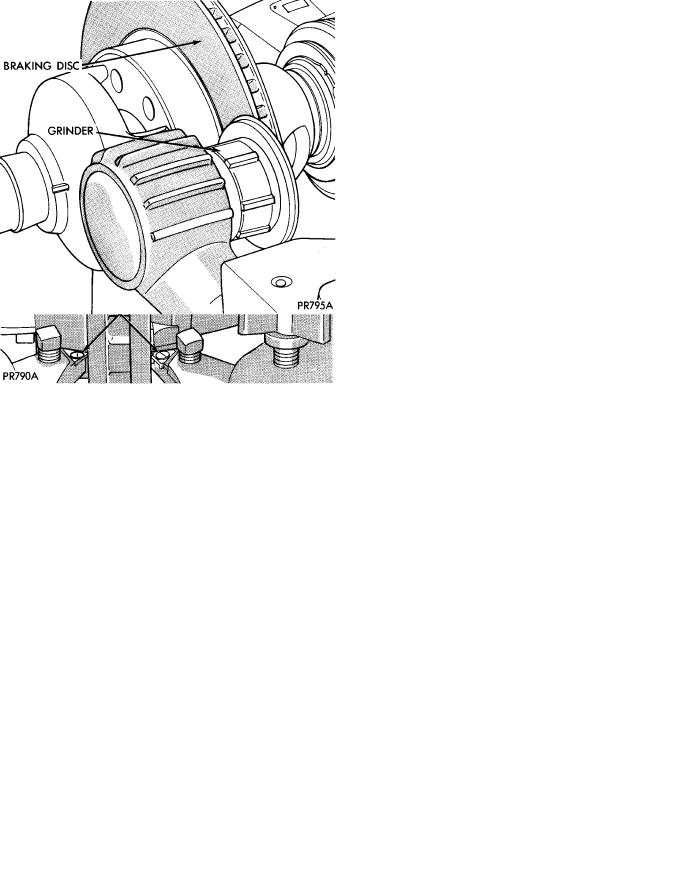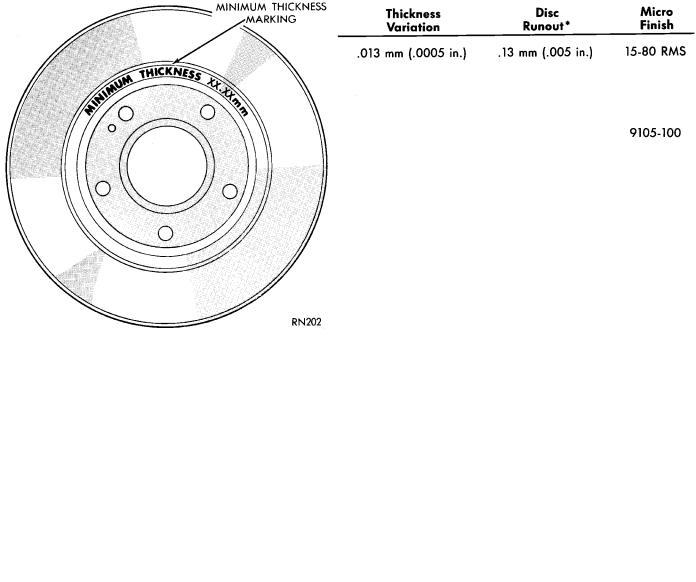
- •GENERAL INFORMATION
- •SERVICE ADJUSTMENTS
- •MASTER CYLINDER FLUID LEVEL
- •ABS BRAKES
- •ADJUSTING REAR SERVICE BRAKES
- •TESTING APPLICATION ADJUSTER OPERATION
- •BLEEDING BRAKE SYSTEM
- •PRESSURE BLEEDING
- •BLEEDING WITHOUT A PRESSURE BLEEDER
- •TEST FOR FLUID CONTAMINATION
- •WHEEL STUD NUT TIGHTENING
- •BRAKE HOSE AND TUBING
- •INSPECTION OF BRAKE HOSE AND TUBING
- •FIG. 10 BRAKE LINE ROUTING NON ABS BRAKES
- •INSTALLATION OF BRAKE HOSE
- •TYPES OF TUBING FLARES
- •TO REPAIR OR FLARE TUBING
- •ISO TUBING FLARES
- •BASIC DIAGNOSIS GUIDE
- •BRAKE SYSTEM DIAGNOSTICS
- •BRAKE SYSTEM DIAGNOSTICS
- •BRAKE SYSTEM DIAGNOSTICS
- •BRAKE SYSTEM DIAGNOSTICS
- •REAR WHEEL DRUM BRAKES
- •DESCRIPTION
- •SERVICE PROCEDURES
- •REAR BRAKE DRUM REMOVAL
- •BRAKE DRUM INSTALLATION
- •BRAKE SHOE ASSEMBLIES
- •REMOVAL
- •CLEANING AND INSPECTION
- •BRAKE SHOE INSTALLATION
- •KELSEY HAYES REASSEMBLE
- •VARGA REASSEMBLE
- •BRAKE DRUM REFACING
- •WHEEL CYLINDERS
- •GENERAL INFORMATION
- •SERVICE PROCEDURES
- •REMOVING WHEEL CYLINDERS FROM BRAKE SUPPORT PLATES
- •DISASSEMBLING WHEEL CYLINDERS
- •ASSEMBLING WHEEL CYLINDERS
- •INSTALLING WHEEL CYLINDERS
- •BRAKE SUPPORT ASSEMBLY
- •REMOVAL
- •INSTALLATION
- •HYDRAULIC SYSTEM CONTROL VALVES
- •GENERAL INFORMATION
- •PRESSURE DIFFERENTIAL WARNING LIGHT SWITCH
- •ABS BRAKE PROPORTIONING VALVE OPERATION
- •HYDRAULIC SYSTEM SERVICE PROCEDURES
- •BRAKE WARNING SYSTEM
- •PROPORTIONING VALVES
- •PROPORTIONING VALVE APPLICATIONS
- •TESTING ABS PROPORTIONING VALVES
- •FRONT DISC BRAKES
- •GENERAL INFORMATION
- •SHOE AND LINING WEAR
- •SERVICE PRECAUTIONS
- •KELSEY HAYES DOUBLE PIN FAMILY CALIPER
- •BRAKE SHOE SERVICE PROCEDURES
- •REMOVAL
- •INSTALLATION
- •SERVICE PROCEDURES
- •BRAKE SHOES REMOVE
- •CLEANING AND INSPECTION
- •BRAKE SHOES INSTALL
- •DISC BRAKE CALIPER DISASSEMBLY
- •CLEANING AND INSPECTION
- •CLEANING AND INSPECTION OF BRAKE CALIPER
- •ASSEMBLING DISC BRAKE CALIPER
- •REAR DISC BRAKES
- •GENERAL INFORMATION
- •LINING WEAR
- •SERVICE PRECAUTIONS
- •BRAKE SHOE REMOVAL
- •CLEANING AND INSPECTION
- •BRAKE SHOE INSTALLATION
- •DISASSEMBLING REAR CALIPER ASSEMBLY
- •CLEANING AND INSPECTION
- •CLEANING AND INSPECTION
- •ASSEMBLING REAR DISC BRAKE CALIPER
- •BRAKE DISC (ROTOR)
- •GENERAL INFORMATION
- •INSPECTION DIAGNOSIS
- •SERVICE PROCEDURES
- •CHECKING BRAKING DISC FOR RUNOUT AND THICKNESS
- •BRAKING DISC REMOVAL
- •INSTALLING BRAKING DISC
- •REFINISHING BRAKING DISC
- •REFACING BRAKING DISC
- •RESURFACING BRAKING DISC
- •BRAKING DISC (ROTOR) REFINISHING LIMITS
- •PARKING BRAKES
- •GENERAL INFORMATION
- •SERVICE PROCEDURES
- •ADJUSTING PARKING BRAKE
- •FIG. 2 PARKING BRAKE CABLE ROUTING AA AND AP BODY
- •FIG. 4 PARKING BRAKE CABLE ROUTING AG AND AJ BODY
- •SELF ADJUSTING PROCEDURES
- •TO RELOAD SELF ADJUSTER
- •ADJUST PARKING BRAKE
- •REAR PARKING BRAKE CABLE REMOVAL
- •DRUM BRAKES
- •DISC BRAKES
- •INSTALLING PARKING BRAKE REAR CABLE
- •DRUM BRAKES
- •DISC BRAKES ALL
- •REMOVING PARKING BRAKE FRONT CABLE
- •INSTALLING PARKING BRAKE FRONT CABLE
- •REMOVAL AG AND AJ BODY
- •INSTALLATION AG AND AJ BODY
- •REMOVAL AND INSTALLATION PARKING BRAKE SHOES
- •ALL WITH REAR DISC BRAKES
- •INSTALLING PARKING BRAKE SHOES
- •MASTER CYLINDER
- •GENERAL INFORMATION
- •BRAKE FLUID LEVEL SENSOR
- •TESTING THE MASTER CYLINDER
- •MASTER CYLINDER SERVICE PROCEDURES
- •MASTER CYLINDER REMOVAL
- •BRAKE FLUID RESERVOIR REPLACEMENT
- •BLEEDING MASTER CYLINDER
- •INSTALLING MASTER CYLINDER
- •POWER BRAKES
- •GENERAL INFORMATION
- •SERVICE PROCEDURES
- •POWER BRAKE BOOSTER ASSEMBLY
- •WHEEL BEARINGS
- •FRONT WHEEL BEARINGS
- •REAR WHEEL BEARINGS
- •NORMAL SERVICE
- •INSPECTION
- •REMOVAL AND INSTALLATION
- •GENERAL INFORMATION
- •NORMAL BRAKING SYSTEM FUNCTION
- •MAJOR ABS COMPONENTS
- •HYDRAULIC ASSEMBLY
- •WHEEL SPEED SENSORS
- •NORMAL BRAKING SYSTEM FUNCTION
- •PEDAL FEEL
- •TIRE NOISE & MARKS
- •ABS EQUIPPED VEHICLE PERFORMANCE
- •ABS WARNING SYSTEMS OPERATION
- •RED BRAKE WARNING LAMP
- •NORMAL OPERATION OF WARNING LAMPS
- •HYDRAULIC ASSEMBLY
- •HYDRAULIC BLADDER ACCUMULATOR
- •DUAL FUNCTION PRESSURE SWITCH
- •PRESSURE TRANSDUCERS
- •DIFFERENTIAL PRESSURE SWITCH
- •PROPORTIONING VALVES
- •FLUID LEVEL SWITCH
- •DUAL FUNCTION PRESSURE SWITCH WIRING DIAGRAM
- •WHEEL SPEED SENSORS
- •PRESSURE SWITCH AND PRESSURE TRANSDUCER WIRING
- •ABS SYSTEM WIRING SCHEMATIC
- •ABS SYSTEM DIAGNOSTIC CONNECTOR
- •SYSTEM RELAY
- •ABS HYDRAULIC CIRCUITS AND VALVE OPERATION
- •NORMAL BRAKING
- •ABS BRAKING SYSTEM DIAGNOSIS
- •GENERAL INFORMATION
- •DEFINITIONS
- •ABS SYSTEM GENERAL SERVICE PRECAUTIONS
- •TEST DRIVING ABS COMPLAINT VEHICLES
- •WHEEL SPEED SENSOR CABLES
- •SPECIAL SERVICE TOOLS
- •INTERMITTENT FAULTS
- •ABS BRAKE SYSTEM DIAGNOSTIC FEATURES
- •SYSTEM SELF DIAGNOSIS
- •BENDIX ABS SYSTEMS DIAGNOSTICS
- •ON CAR HYDRAULIC ABS COMPONENT SERVICE
- •GENERAL SERVICE PRECAUTIONS
- •CHECKING BRAKE FLUID LEVEL
- •BLEEDING ABS BRAKE SYSTEM
- •BRAKE FLUID PRESSURE AND RETURN HOSES (FIG. 6)
- •INSTALL
- •HYDRAULIC ASSEMBLY
- •BRAKE FLUID RESERVOIR
- •HYDRAULIC BLADDER ACCUMULATOR
- •PROPORTIONING VALVES (FIG. 17)
- •ELECTRONIC COMPONENTS
- •WHEEL SPEED SENSORS
- •FRONT WHEEL SPEED SENSOR
- •REAR WHEEL SPEED SENSOR (FIGS. 13 AND 15)
- •GENERAL INFORMATION
- •NORMAL BRAKING SYSTEM FUNCTION
- •MAJOR COMPONENTS
- •MASTER CYLINDER AND VACUUM BOOSTER
- •WHEEL SPEED SENSORS
- •PEDAL FEEL
- •TIRE NOISE & MARKS
- •VEHICLE PERFORMANCE
- •WARNING SYSTEMS OPERATION
- •NORMAL OPERATION OF WARNING LAMP
- •MODULATOR ASSEMBLY
- •ISOLATION VALVES
- •SHUTTLE ORIFICE
- •FLUID SUMPS
- •HYDRAULIC SPRING ACCUMULATOR
- •PROPORTIONING VALVES
- •WHEEL SPEED SENSORS
- •DIAGNOSTIC CONNECTOR
- •SYSTEM RELAY
- •HYDRAULIC CIRCUITS AND VALVE OPERATION
- •NORMAL BRAKING
- •ABS BRAKE SYSTEM DIAGNOSIS
- •GENERAL INFORMATION
- •DEFINITIONS
- •ABS COMPUTER SYSTEM SERVICE PRECAUTIONS
- •ABS GENERAL SERVICE PRECAUTIONS
- •TEST DRIVING ABS COMPLAINT VEHICLES
- •ABS BRAKE SYSTEM ON VEHICLE SERVICE
- •WHEEL SPEED SENSOR CABLES
- •SPECIAL SERVICE TOOL
- •INTERMITTENT FAULTS
- •ABS BRAKE SYSTEM DIAGNOSTIC FEATURES
- •ABS SYSTEM SELF DIAGNOSIS
- •BENDIX ABS SYSTEMS DIAGNOSTICS
- •GENERAL SERVICE PRECAUTIONS
- •CHECKING BRAKE FLUID LEVEL
- •MODULATOR ASSEMBLY (FIG. 2)
- •MASTER CYLINDER AND POWER BOOSTER
- •PROPORTIONING VALVES (FIG. 5)
- •ELECTRONIC COMPONENTS
- •WHEEL SPEED SENSORS
- •FRONT WHEEL SPEED SENSOR (FIG. 12)
- •REAR WHEEL SPEED SENSOR (FIGS. 13 AND 14)
- •SPECIFICATIONS
- •SPECIFICATIONS METRIC
- •BRAKE ACTUATION SYSTEM
- •TIGHTENING REFERENCE

Ä |
|
BRAKES 5 - 55 |
|
Light scoring and/or wear is acceptable. If heavy scoring or warping is evident, the disc must be refinished or replaced (See Refinishing/Refacing Braking Disc). If cracks are evident in the disc, replace the disc.
BRAKING DISC REMOVAL
(1)Raise vehicle on hoist or jackstands. Remove wheel and tire assembly.
(2)Remove caliper assembly, as described under Brake Shoe Removal in this Group, (but do not disconnect brake line). Suspend caliper from wire hook or loop to avoid strain on flexible hose.
(3)Remove braking disc from the hub.
INSTALLING BRAKING DISC
(1)Slide braking disc on hub. Clean both sides of braking disc with alcohol or suitable solvent.
(2)Install caliper assembly, as described in Brake Shoe Installation paragraph.
REFINISHING BRAKING DISC
REFACING BRAKING DISC
Refacing of the braking disc is not required each time the shoe assemblies are replaced.
If the braking disc surface is deeply scored or warped or there is a complaint of brake roughness or pulsation the rotor should be resurfaced or refaced (Figs. 6 and 7).
Fig. 6 Refacing Braking Disc
Fig. 7 Resurfacing Braking Disc (Final Finish)
When refacing a braking disc the required 0.10 mm (0.004 inch) TIR (Total Indicator Reading) and 0.013 mm (0.0005 inch) thickness variation limits MUST BE MAINTAINED. Extreme care in the operation of braking disc turning equipment is required.
The collets, shafts and adapters used on the brake lathe, and the bearing cups in the rotor MUST be clean and free from any chips or contamination.
When mounting the disc on the brake lathe, strict attention to the brake lathe manufacturer's operating instructions is required.
If the disc is not mounted properly the run-out will be worse after refacing than before refacing.
The use of a double straddle cutter (Fig. 6) that machines both sides of the disc at the same time is highly recommended.
RESURFACING BRAKING DISC
This operation can be used when the disc surface is rusty or has lining deposits.
A sanding disc attachment will remove surface contamination without removing much braking disc material.
It will generally follow variations in thickness that are in the disc.
The following chart shows the location of measurements and specifications when servicing the braking disc.
All braking discs have markings for minimum allowable thickness cast on an un-machined surface of the braking disc (Fig. 8). The thickness markings may be located on the disc as shown in (Fig. 8) or on an alternate surface.
This marking includes 0.76 mm (0.030 inch) allowable disc wear beyond the recommended 0.76 mm(0.030 inch) of disc refacing.

5 - 56 BRAKES |
|
Ä |
|
Fig. 8 Minimum Thickness Markings
